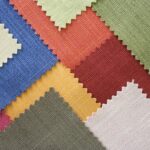Polyester is a synthetic fabric with a fascinating history, making it a unique contender in the world of textiles. This blog will delve into the origins of polyester, its various applications, its journey in the garment industry, and how clothing made from 100% polyester fares in comparison to other fabrics like cotton and linen.
The Origin of Polyester:
Polyester is a synthetic polymer created through a chemical process involving petroleum, air, and water. It was first introduced in the early 20th century and became a staple in various industries, including textiles, due to its durability, wrinkle resistance, and versatility.
Polyester in Clothing:
Polyester’s foray into the clothing industry began in the mid-20th century. Its ability to mimic natural fibers, such as silk and cotton, while offering enhanced features, made it an attractive choice for garments. Today, polyester is commonly used in sportswear, activewear, outerwear, and a wide range of apparel.

Advantages of 100% Polyester:
- Durability: Polyester is known for its resistance to wear and tear, making it long-lasting.
- Wrinkle Resistance: Polyester garments tend to hold their shape and resist wrinkles better than natural fabrics.
- Moisture-Wicking: Polyester has excellent moisture-wicking properties, making it ideal for sportswear and activewear.
- Colorfastness: It retains colors well and resists fading, even after multiple washes.
- Quick Drying: Polyester dries faster than cotton, making it suitable for wet or humid conditions.
Disadvantages of 100% Polyester:
- Breathability: Polyester is less breathable than natural fibers like cotton, which can lead to discomfort in hot weather.
- Environmental Concerns: The production of polyester involves the use of fossil fuels and generates greenhouse gases.
- Static Cling: Polyester is more prone to static electricity and clinging to the body.
Polyester vs. Cotton:
- Comfort: Cotton is often considered more comfortable due to its breathability and softness.
- Moisture Management: Cotton absorbs moisture, but it does not wick it away like polyester, making it less suitable for intense physical activities.
- Durability: Polyester tends to be more durable and retains its shape better than cotton.
- Wrinkle Resistance: Polyester excels in wrinkle resistance, while cotton is more prone to wrinkling.
- Environmental Impact: Cotton is a natural, renewable resource, while polyester’s production has more environmental concerns.

Polyester vs. Linen, Wool, and Rayon:
- Linen: Linen offers excellent breathability and a natural, textured appearance. It is ideal for summer wear but wrinkles easily.
- Wool: Wool provides superior insulation and moisture-wicking properties. It is commonly used in cold-weather clothing but may be less comfortable in warmer climates.
- Rayon: Rayon is a semi-synthetic material known for its silky feel and moisture-wicking capabilities. It bridges the gap between natural and synthetic fabrics.
In conclusion, the choice between 100% polyester and cotton depends on your preferences, needs, and the intended use of the garment. Polyester offers durability, quick-drying properties, and moisture-wicking abilities, making it ideal for sportswear and outdoor activities. Cotton, on the other hand, is prized for its natural comfort and breathability, making it a classic choice for everyday wear. Both fabrics have their advantages and drawbacks, and selecting the right one comes down to your specific requirements.







